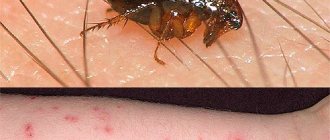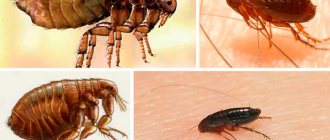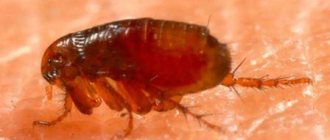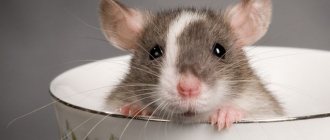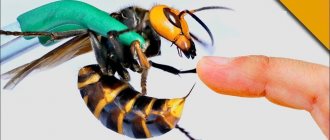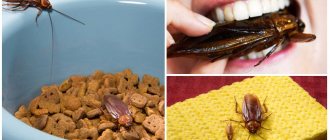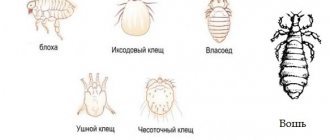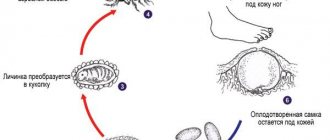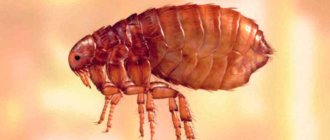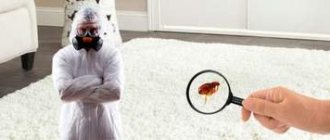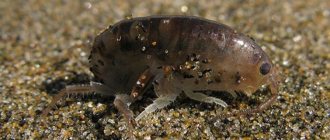Fleas belong to the Siphonaptera family and are parasites that feed on the blood of their host. Insects are ubiquitous. If your pet has fleas, they pose a danger to humans.
Having passed from the larvae to the adult stage, fleas begin to search for a food source. They move mainly by jumping, deftly jumping into the fur of animals. With a body size of 2-4 mm, the flea's jump height reaches 20 cm and length - 40 cm. Among insects, only pennies surpass fleas with record jumps of up to 70 cm in height! This is a hundred times their own height. The body of both types of insects contains resilin, a protein with the ability to accumulate elastic energy, which helps when jumping.
Interesting fact: in proportional terms, for a man 2 meters tall, a flea jump is equivalent to jumping 48 meters in height and 90 meters in length!
Having entered an apartment through pets, the parasites sometimes bother people with their bites. And fears that cat fleas are dangerous to humans are actually not unfounded.
Are fleas dangerous for humans?
Fleas are insects that are not very particular about what they eat. They indiscriminately attack animals and birds. They will not disdain humans either.
The allergen is insect saliva. The human body can react to a bite in different ways. For some, it is a ten-minute itch, while for others, the whole complex of allergic reactions manifests itself.
A huge number of subspecies of worms carried by insects can cause a number of diseases. Many of which become chronic and are fraught with serious consequences for the body.
Psychological discomfort
Parasite bites are stressful for representatives of a civilized society. Unlike lice, they are perceived as exclusively animal parasites. Indeed, cat fleas rarely bite the pet owner.
A greater risk is created by arthropods that have occupied carpets, upholstered furniture and other furnishings. Bite marks are seen as a sign of poor hygiene - an unpleasant conclusion for people who care about cleanliness and accidentally become infected with parasites.
The pain caused by insect bites disrupts sleep, increases nervousness and impairs the ability to concentrate on the work at hand. Similar changes in behavior are provoked by itching from bites.
What types of fleas pose a threat to humans?
These parasites have plagued humanity for many centuries. Previously, they were confused with lice. But lice live mainly on the head and groin and they are immobile. Fleas, on the contrary, choose the hairless part of the skin. And they are able to move at lightning speed.
Human fleas: what they look like and how to get rid of fleas on humans, read more in the article here.
There are about 2000 species of fleas in the world. Their Latin name comes from the mammal on which they primarily live. Absolutely all varieties of flea bloodsuckers are carriers of dangerous infectious diseases, so each of them poses a threat to human health.
This is interesting! If people developed the jumping abilities of fleas, they could jump to a height of 135 meters. And up to 260 meters in length.
Rat
Maximum danger! Fleas that live on rats carry a deadly disease called plague. Rat parasites are not just one specific type of parasite, but a whole range of them. Habitat: all types of small rodents.
By sight they cannot be distinguished from the others. Laboratory examination will be required for classification. In modern houses they are becoming less and less common, but in rural areas it is quite possible to encounter them.
Pests do not live on rats and mice; they only feed on their blood and waste residues. Their main habitat is rat holes. Therefore, in order to get rid of them you need to find these places.
Doggystyle
Habitat: dog fur or bedding. The eggs laid are spread over an impressive territory. Wingless blood-sucking – imago. Externally similar to a cat flea.
Read more about what fleas look like and how dangerous they are on dogs in this article.
Fleas are transmitted from dog to person, they jump on people, mainly affecting the lower limbs. Therefore, the risk of infection remains high.
Adult ectoparasites make up only 5% of all four stages of a flea colony. The bulk are larvae, pupae and eggs. Therefore, it is necessary to fight not only with parasites that were found on a pet.
Felines
A wingless arthropod that feeds on the blood of cats. Although they will not disdain dog blood. If there are rodents in the house, then the cat flea can live in their burrows.
The best products for killing cat fleas
When a person is bitten, the legs below the knees are mainly affected. Life expectancy is up to one and a half years. Like all species, adults go through four life stages:
- egg;
- larva;
- chrysalis;
- adult.
The bite is characterized by burning pain. An animal massively infected with this parasite may die from anemia.
They are carriers of dangerous infections: rickettsiosis, plague, brucellosis. Therefore, cat fleas are dangerous to humans. In addition, their saliva can provoke a severe allergic reaction.
general characteristics
Fleas are classified as obligate and ectoparasites (that live on the body of their host) that feed exclusively on blood. The usual habitat of these insects is the fur of warm-blooded animals (for example, dogs, cats, birds and others).
It happens that these parasites choose a person to satisfy hunger or transport. Most often, it turns out to be a temporary host , since the human body is unsuitable for their life:
- does not have a rich coat of hair;
- low body temperature (lower than in animals);
- compliance with hygiene standards.
There are an incredible number of these ectoparasites (about 2000), but the most common types are the following:
- Living on pets and other animals, birds.
- Earth (or human).
- Bedding (found in pillows and mattresses).
- Sandy.
Parasites of animals and birds
Rat flea bites pose a great danger to humans , since they are the causative agents of serious diseases (plague, typhoid, etc.). Dog parasites are almost indistinguishable from human fleas and carry the same diseases.
Cat fleas are carriers of many infectious diseases and fungal viruses, as well as various helminths (for example, flatworms, roundworms, echinococci). Cat parasites are the most common.
Infection with ectoparasites is also typical for birds. So, you need to be careful not only in places where they accumulate (nests, chicken coop, pigeon coop, etc.), but also on city streets. The pigeon parasite is most often found not only in domestic birds, but also in stray birds.
Therefore, do not contact them (especially sickly-looking individuals), because they are carriers of diseases (for example, salmonellosis).
Sand fleas . These parasites are small in size. They are most often found in the tropical and equatorial zones and live in the sands near the sea. Their activity increases at dawn and dusk. It is worth noting: the danger of sand parasites is that when they bite, they lay larvae that come out and live in the floor.
Human flea
The ectoparasite of this species is characterized by the following:
- Quite large sizes.
- Dark brown color.
- The female is capable of laying about 8 eggs at a time.
- The life cycle lasts about a year.
- Movement occurs by jumping.
- Carries some parasitic flatworms and worms.
- The causative agent of various diseases.
During World War II, the Japanese used fleas as a biological weapon , killing about half a million people.
Paths of transition from animals to humans
Anyone can find a flea in the house or on their body. Pet owners are more likely to have them. Dogs and cats bring them from the street. But this does not mean that once you get rid of your pets, your home is safe.
Dog fleas are transmitted to humans through direct contact with outdoor animals. These bloodsuckers are excellent high and distance jumpers. The length of the jump can reach one and a half meters.
In addition, street dirt contains their eggs, and they enter the house on shoe soles. The first floors of apartment buildings are a risk zone. The basement is full of moisture and debris - an ideal place for parasites.
Where to begin
If you discover parasites in your home, act immediately. First of all, do some general cleaning.
- Wash curtains, bed linen, blankets and rugs.
- Wash floors, walls, door frames, windows.
- In the warm season, take pillows, mattresses, carpets outside, beat them out and leave them under the scorching rays of the sun for 2 hours.
- Fleas cannot stand the heat, so they immediately leave their homes. In winter, treat things with a steam cleaner.
Go through the contents of your wardrobes. Get rid of old unnecessary things. Eliminate leaking faucets, seal cracks in baseboards and pipe joints with sealant. Select a high-quality insecticidal preparation and carry out disinfestation.
Signs of pests
The first and main sign is bites. The marks are almost invisible, but the sensation is not pleasant. Itching and burning at contact points. The main impact falls on the legs. But in advanced cases, especially if pets sleep in bed with their owners, bites will be on the back and arms.
If there is a cat or dog living in the house, then by their behavior you can understand that they have fleas. Animals become irritable and their appetite decreases. The animals' attempts to bite or scratch something on the body are noticeable. The areas of the head, tail and ears are most vulnerable.
Interesting fact! A certain type of flea, Glaciopsyllus antarcticus, can be frozen for a year, and after thawing it will feel great. In normal life, they live in Antarctica and settle in the nests of petrels and Cape pigeons.
Preventive measures
How to protect yourself and your loved ones from parasite bites? There is a high probability that they can appear in any apartment, since the ways of their penetration are varied. But you can minimize unpleasant “communication” by following simple rules:
- when hiking in nature, cover all exposed areas of the body;
- do not visit unsanitary places;
- keep order in the house;
- repel fleas by treating yourself with Off-Extreme, Biban, Gall-Rat;
- do not touch stray animals.
These measures will protect against human fleas entering the house and will relieve you from unpleasant bites and subsequent treatment of the apartment.
Modern means make it possible to keep everyone’s home perfectly clean, protecting them from emerging insects. Many of them have adaptive mechanisms that allow them to survive in unfavorable conditions. But patience and the desire to live in purity and peace will help you take the necessary countermeasures and solve the difficult problem of “uninvited guests.”
Consequences of flea bites
Perhaps the bites will pass without any consequences. Someone may have a severe allergic reaction and cannot do without anti-allergens. But much more dangerous are infectious pathogens that are carried in flea saliva from infected or dead animals.
Fact! The risk of catching worms during a flea bite is very high. And this does not apply only to humans. All mammals that have been attacked by adult adults can receive helminths “as a gift.”
Do cat and dog fleas bite people and how to get rid of them, read more in the article here.
The most popular anthelmintic drugs
| Name | Description | Minuses |
| Febtal combo | The active ingredients praziquantel and albendazole are active against round and tapeworms. | Not allowed during lactation and pregnancy. |
| Name | Description | Minuses |
| Drontal Junior | The active ingredients febantel and pyrantel embonate are active against roundworms. | Not a wide spectrum of action. |
| Name | Description | Minuses |
| Kanikquantel | The active ingredients praziquantel and fenbendazole are active against roundworms and tapeworms. This is not quite a suspension - it is a gel. | High price. |
Diseases carried by insects
Depending on the region of residence and the time of year, fleas can infect humans with very dangerous diseases. Some of them, such as the plague, are deadly. In the Middle Ages, according to various estimates, about 50,000,000 people died from bubonic and pneumonic plague.
Hymenolepiasis
These worms live in the small intestine. Half of the sick survive the infection without any symptoms. In other cases, the following are possible:
- skin rash;
- diarrhea;
- heartburn;
- cramping abdominal pain;
- nausea;
- a sharp decrease in appetite;
- reduction in body weight.
In rare cases, dizziness, fainting, convulsions and Quincke's edema. Diagnosis is made based on clinical examination of stool.
Dipylidiasis
This worm reaches a length of 30–40 cm, lives in the intestines and is attached to the walls with special hooks. In its advanced form it affects the gastric system.
Infection occurs through the oral-fecal route or through flea bites that carry the pathogen in their saliva.
Symptoms:
- periodic abdominal pain;
- severe itching in the anal area;
- weight loss and appetite;
- headache.
Allergic manifestations on the skin are possible, in the form of redness and itching. Pale mucous membranes and skin.
Diagnostics: stool test for worm eggs, urine test and general blood test. Feces must be collected three times. And doctors look at blood and urine in order to understand how much the cucumber tapeworm managed to harm the body.
Treatment depends on the severity of the disease. Anthelmintic drugs first. Everything else depends on the tests. It is possible to prescribe antispasmodics to reduce pain. Iron supplements at the onset of anemia. B vitamins. Probiotics and enzymes for the pancreas.
Helminths
Parasitic worms, simply called worms. Science has identified three main types of these parasites:
- round – nematodes (pinworms, roundworms);
- flat, tape - cestodes (echinococci, various tapeworms);
- parasitic flukes – trematodes.
Infection occurs in different ways, including through flea bites.
Under no circumstances should you self-medicate, since most helminths severely undermine human immunity. The degree of damage can only be determined by a doctor, based on the results of laboratory tests of blood, feces and urine.
Plague
An incredibly dangerous disease. From Latin pestis. The carrier is the bacterium Yersinia pestis. Plague can be contracted from a flea if it has previously been in contact with a sick animal. An imago can also pick up the plague bacillus from a dead, sick animal.
The incubation period of the disease in humans is 2–8 days. You can become infected with the plague through airborne droplets, through tissue contact with a sick animal, and through the bite of an infected flea.
The mortality rate from bubonic plague is 50%, and pneumonic plague always ends in death if treatment is not started in time.
Typhus
From Latin typhus. A serious infectious disease caused by bacteria from the Rickettsia prowazekii group.
The transmission method is transmission. From sick to healthy through the bite of lice, fleas and ticks. Main symptoms:
- specific rash on the body;
- feverish condition;
- serious damage to the nervous system;
- cardiovascular problems.
There are two types: epidemic and endemic.
It is epidemic typhus that spreads through the bites of fleas and lice. They can transmit infection from person to person or from sick rats to people. This is rare in the modern world. For such an epidemic to start, people must live in terrible unsanitary conditions.
After bacteriological tests, the doctor prescribes a course of antibiotics.
Sarcopsillosis or tungiasis
Tropical parasitic disease, from Latin Sarcopsyllosis, Tungiasis.
The source of infection can be a penetrating flea (Brazilian ground flea). The habitat of this flea, and therefore the place where you can become infected with this disease:
- Caribbean countries;
- South and Central America;
- India;
- tropical part of Africa.
Symptoms of a Brazilian bloodsucker bite are severe itching, redness and a visible wound at the site of infestation.
These fleas are scary because they lay eggs under human skin. The toes are especially susceptible. Nail plates. Various bacteria penetrate the body through the wound.
Treatment only by a specialist. You cannot remove it yourself. Otherwise, even part of the flea remaining in the body can lead to a serious infection. The risk of re-infection remains. Result: tetanus and gangrene!
What can you get infected with?
The likelihood of contracting a fatal disease from the bite of a random flea is small, but there is always a risk. When a representative of a blood-sucking species penetrates and penetrates the skin, further developments can be very diverse and unpredictable.
Bacterial infections
The danger of fleas to humans is that they are capable of transmitting the following infections:
- Plague. An extremely contagious disease caused by the bacterium Yersinia pestis. Fleas are carriers of this pathology with a high probability of death. This quarantine infection is extremely severe and includes fever, damage to the lymphatic system, lungs and other internal organs.
- Salmonellosis. An infectious disease that primarily affects the gastrointestinal tract and is caused by Salmonella. Chicken fleas are often carriers of the pathogen. This bacterial pathology is characterized by symptoms of acute intoxication, accompanied by diarrhea, vomiting, dermatological rashes and complete digestive disorders.
- Tularemia. The causative agent of this zooanthroponotic infection is the bacterium Francisella (Francisella tularensis). The carriers of this disease are blood-sucking insects, including fleas. Tularemia is accompanied by severe symptoms of general intoxication. It affects the lymphatic system, affecting the organs of vision and breathing.
- Listeriosis. A deadly infection caused by the bacterium Listeria monocytogenes. Most often, infection occurs through contaminated water and food products of animal origin. Although fleas are also occasionally carriers of it. There are four forms of the disease: glandular, gastroenteric, nervous and septic.
- Brucellosis. An infectious disease characterized by an acute course, the causative agent of which is microorganisms of the genus Brucella. The pathogen enters the human body through animal products that have not undergone high-quality heat treatment. And sometimes this disease is carried by fleas or other blood-sucking animals.
Blood-sucking, as carriers of diseases, are quite often responsible for fungal pathologies.
Diseases caused by protozoa
If you are interested in what diseases fleas carry, you can discover such a pathology as Chagas disease. It is a parasitic disease caused by the protozoan Trypanosoma cruzi. A person becomes infected with this disease through the bites of bedbugs or fleas. This pathology is more often diagnosed in the tropics. Chagas disease affects the nervous, cardiovascular and gastrointestinal systems.
Often causes swelling of the brain.
Viral diseases
Fleas are dangerous to humans because they can cause viral encephalitis. Most often, human infection occurs from mammals through ticks, less often fleas. This disease causes damage to brain tissue. If therapy is not started in a timely manner, then for a person this is fraught with the development of paralysis.
Is it possible to become infected with HIV or hepatitis C?
HIV and the hepatitis C virus cannot exist outside the human body. Theoretically, if a blood-sucking parasite first bit a sick person and then squirted a portion of blood into a healthy one, then infection could occur. But a bite does not imply such a mechanism.
In addition, even if we consider that there is a small portion of infected blood in the parasite’s proboscis, there is nothing to worry about, since the hepatitis or HIV virus dies in the external environment within a few minutes. Thus, infection with these terrible viral infections does not occur through blood-sucking insects.
Do they carry rabies?
Some people are concerned not only about themselves, but also about the health of their pets, so they are interested in whether fleas carry rabies. When a blood-sucking animal comes into contact with a pet, infection successfully occurs. Most often, rabies occurs in dogs and this forces them to be euthanized.
Worms
Worm parasites (helminth eggs) are actively carried by fleas. If dog fleas containing tapeworm larvae penetrate into the human oral cavity, then infection is inevitable. Blood-sucking parasites temporarily carry helminths. Once worms settle in the human body, they can live there for about a year without causing any symptoms.
Another clinical case of helminth infection through contact is rat tapeworm. It is detected in fleas living on rats. The helminth egg is swallowed by the larva of the blood-sucking parasite, and then a worm is formed from the egg inside it. Human infection occurs when a flea with a helminth enters the oral cavity.
How to protect yourself and your pets from blood-sucking parasites
All pet lovers should remember that fleas are dangerous to humans from both cats and dogs. Therefore, you need to monitor the cleanliness of your pets no less than the cleanliness of your home.
Doctors recommend that the whole family take anthelmintic tablets every year. And if there are animals in the house that regularly go outside, then every 6 months.
First you need to carry out disinfestation of the outside of the house/apartment. Basements, landfills, attics - everything must be regularly cleaned of debris. Inside the apartment, general cleaning with special cleaning products. Special anti-flea shampoos and collars for cats and dogs are required.
Brief table of anti-flea drugs.
| Name of the drug | Description |
| "Raptor" | Spray, safe for humans. Nice smell |
| Get | Microcapsules diluted in water. Safe for humans |
| "Biorin" | Professional product with an unpleasant odor. For use only by certified pest control services. |
Flea infestation is easier to prevent than to treat. Therefore, all methods are used. From strong chemicals, which are abundant on the shelves of veterinary stores, to folk methods. For example, branches of dried wormwood in the corners of the house will repel parasites. Washing floors with hot water, soap and kerosene (300 grams + 100 grams + 10 liters) is also an excellent means of prevention.
Prevention
Prevention includes comprehensive measures that create unacceptable living conditions for parasites. Clean the apartment of dust, throw out trash, get rid of old furniture and carpets, and avoid dampness.
For pets, purchase parasite-repellent collars and use insecticidal shampoos for bathing. Regularly shake out animal bedding, clean the cages of birds and rodents.
Once a week, wash the floors in your house by adding a decoction of wormwood or geranium essential oil to the water. Under the carpets, in the ventilation hole, place sprigs of mint, rosemary, and lavender. Fleas hate strong odors, so they will avoid the apartment.
